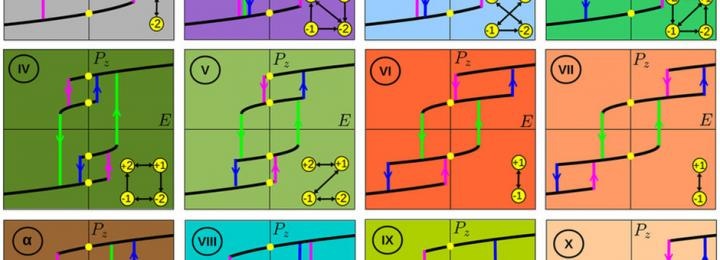Feb 13 2017
 A team of researchers from Argonne, the Lille University of Science and Technology and the University of Picardie Jules Verne have laid out a theoretical map to use ferroelectric material (a class of materials whose polarization can be controlled with electric fields) to process information using multivalued logic � a leap beyond the simple ones and zeroes that make up our current computing systems that could let us process information much more efficiently. The diagram shows the configurations (yellow dots) where stable energy positions could allow us to encode information in thin films of ferroelectric material. (Image credit: Baudry/Lukyanchuk/Vinokur.)
A team of researchers from Argonne, the Lille University of Science and Technology and the University of Picardie Jules Verne have laid out a theoretical map to use ferroelectric material (a class of materials whose polarization can be controlled with electric fields) to process information using multivalued logic � a leap beyond the simple ones and zeroes that make up our current computing systems that could let us process information much more efficiently. The diagram shows the configurations (yellow dots) where stable energy positions could allow us to encode information in thin films of ferroelectric material. (Image credit: Baudry/Lukyanchuk/Vinokur.)
A study recently published in Nature Scientific Reports presents a theoretical map to use ferroelectric material in order to process information using multivalued logic. This is considered to be a jump beyond the simple zeroes and ones that make up the existing computing systems that could allow processing of information in a more efficient manner.
Only two symbols, zeroes and ones also meaning yes or no, are used to write the language of computers. However, expanding to three or more values will make room for richer possibilities, resulting in the same physical switch to encode much more information.
“Most importantly, this novel logic unit will enable information processing using not only “yes” and “no”, but also “either yes or no” or “maybe” operations,” said Valerii Vinokur, a materials scientist and Distinguished Fellow at the U.S. Department of Energy’s Argonne National Laboratory and the corresponding author on the paper, along with Laurent Baudry from the Lille University of Science and Technology and Igor Lukyanchuk from the University of Picardie Jules Verne.
This is the way that the human brain functions and they are something on the order of a million times more competent than the most excellent computers that have ever been built, while consuming orders of magnitude less energy.
Our brains process so much more information, but if our synapses were built like our current computers are, the brain would not just boil but evaporate from the energy they use.
Valerii Vinokur, Materials Scientist, Argonne National Laboratory
Even though this type of computing, known as multivalued logic, has been known for a long time, researchers are yet to discover a material system capable of using it. Currently, it is possible for transistors to only operate as Off or On, so this new system will have to discover a new way to regularly maintain more states, and also to be easy to read and write and, preferably to operate at room temperature.
This is the reason why Vinokur and team are interested in ferroelectrics, referring to a category of materials whose polarization can be controlled with electric fields. Ferroelectrics are increasingly useful in sensors and other devices, such as ultrasound and medical machines, as they can physically change shape when changes in the polarization take place.
Scientist are immensely interested in tapping these properties for computer memory and several other applications, but the theory behind their behavior is yet to be fully established.
The new paper presents a solution that will help tap the properties of extremely thin films of a specific class of ferroelectric materials called perovskites.
Based on the calculations, perovskite films have the potential to hold two, three, and even four polarization positions that are actively stable – “so they could ‘click’ into place, and thus provide a stable platform for encoding information,” Vinokur said.
Vinokur stated that the researchers calculated these stable configurations and also studied how to use electric fields and control the polarization in order to move it between stable positions.
When we realize this in a device, it will enormously increase the efficiency of memory units and processors. This offers a significant step towards realization of so-called neuromorphic computing, which strives to model the human brain.
Valerii Vinokur, Materials Scientist, Argonne National Laboratory
Vinokur further stated that the team is currently working with experimentalists to use the principles to develop a working system.
The study, titled “Ferroelectric symmetry-protected multibit memory cell,” was published February 8. The European Commission and the U.S. Department of Energy Office of Science (Materials Science and Engineering Division) supported the research.